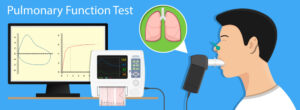Spirometry
Spirometry is a common pulmonary function test used to assess how well your lungs function by measuring the amount of air you can inhale and exhale and the rate at which you can do so. It is a valuable tool for diagnosing and managing respiratory conditions such as asthma, chronic obstructive pulmonary disease (COPD), and other lung diseases.
Indications for Spirometry:
1. Diagnosis of respiratory conditions: Spirometry is often used to diagnose conditions like asthma, COPD, and other lung diseases.
2. Monitoring disease progression: For patients with known respiratory conditions, spirometry helps monitor the progression of the disease and assess the effectiveness of treatment.
3. Preoperative evaluation: In some cases, spirometry is performed before surgery to evaluate lung function and determine the patient's fitness for anesthesia and surgery.
4. Occupational health assessments: Spirometry may be required for certain occupations to assess the potential impact of work-related exposures on lung function.
5. Assessing response to bronchodilators: In cases of suspected asthma, spirometry can be used to measure lung function before and after using a bronchodilator to determine if there is an improvement in airflow.

Prerequisites for Spirometry:
1. No recent respiratory infections: Spirometry should not be performed during an acute respiratory infection or within four weeks of an upper respiratory tract infection.
2. No recent thoracic or abdominal surgery: Patients who have had recent chest or abdominal surgery may need to delay spirometry until they have sufficiently recovered.
3. Understanding and cooperation: The patient needs to understand the instructions for the test and cooperate during the procedure to obtain accurate results.

Interpretation of Spirometry:
Spirometry provides several essential measurements, but the most crucial parameters include:
1. Forced Vital Capacity (FVC): The maximum amount of air a person can forcefully exhale after a deep inhalation. It measures the lung's total capacity to inhale and exhale.
2. Forced Expiratory Volume in one second (FEV1): The volume of air exhaled during the first second of the FVC test. It reflects the amount of air a person can forcefully exhale in one second.
3. FEV1/FVC ratio: This ratio is calculated by dividing the FEV1 by the FVC and is expressed as a percentage. It is used to determine if there is airflow limitation and helps in diagnosing obstructive lung diseases like asthma and COPD.
4. Peak Expiratory Flow (PEF): The maximum flow rate of air during a forced expiration. It is commonly used to monitor asthma and assess its severity.
Interpretation of spirometry results is done by comparing the obtained values with reference or predicted values based on age, sex, height, and ethnicity. A lower FEV1/FVC ratio and reduced FEV1 compared to the predicted values may indicate obstructive lung diseases, whereas a reduced FVC may suggest restrictive lung diseases.
The interpretation of spirometry results should always be done by a qualified healthcare professional, usually a pulmonologist or respiratory therapist, who takes into account the patient's clinical history and other relevant factors to arrive at an accurate diagnosis.

